What a salesman sample is, in concept, has not changed for millennia. Before the industrial Revolution, artists, tailors and dressmakers, blacksmiths and pottery makers all used salesman samples before an artisan or smith spent time in fabrication. The Industrial Revolution didn’t change what salesman samples were. Instead, it expanded the definition and made salesman samples a necessity for commerce.
WORDS MATTER
As with most things regarding social evolution, sometimes words get in the way of concepts. “Salesman Sample” today has three definitions:
- A small sampling of an item given for free to entice customers to pay for a larger amount later
- A store’s displayed item that all customers test out
- A small, proportional example of an item to be fabricated on a larger scale
Let Rock Auction Gallery sell your antiques
Obviously, there are sometimes a lot of overlap. This H.J Heinz steam table was a salesman sample kit to pass out samples of Heinz new soup flavors. For as long as prepared foods and dyed fabrics have been part of humanity, the first definition has been with us. The second definition is seen in the picture below from the 1910 Balochistan (or "Beluchistan," a region between Afghanistan, Pakistan, and Iran) - a salesman would have products he would show, the customer would order, and get an brand new typewriter in the mail. In brick and mortar stores, a business would even sell off their floor displays and salesman samples, perfect for those on a budget who didn't mind a little wear. It's definition number three that most comes to mind in the world of antiques.
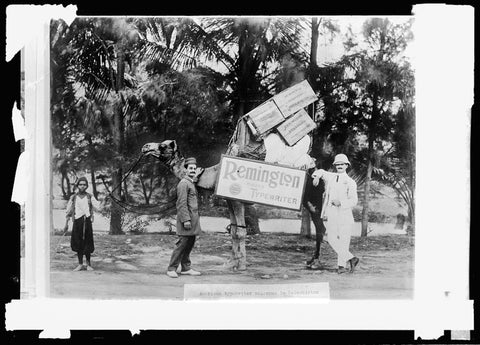
For tens of thousands of years, craftsmen and women were the backbone of a community creating tools, sewing and tailored clothes, creating metalwork, carving stone, processing raw materials, crafting them into something usable for others in the community to use. Because laborious crafts couldn’t waste a lot of time, having samples and examples where imperative to keeping pre-fabrication design process to a minimum. A great example is from the textile world and the most famously dressed woman Marie Antoinette and her Mistress of the Robes, Geneviève de Gramont.
It made sense that woodworkers offered miniature examples to enticed new customers to say "Yes." Before a designer selects lighting finishes or clay tile, handling samples and examples were key. Once the Industrial Revolution was in full swing, every company made salesman samples to entice new customers around the world.
Salesman Sample Strelinger Lathe
POST-INDUSTRIAL REVOLUTION
As manufacturing and metalcraft around the world experienced their renaissance, salesman samples became imperative and instrumental in giving the customer the best options to migrate from their old ways to the world of new invention and innovation. For many urban areas, miniature samples allowed a seller to offer as many options as possible in small condensed spaces. This previous post covers Detmer Woolens use of sample boxes, and how it drastically reduced the amount of space a tailor needed to occupy in order to work by eliminating cumbersome storage of rarely-used fabrics.
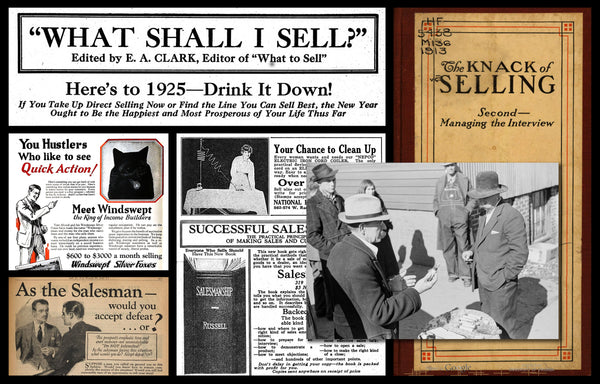
The Transcontinental Railroad being completed in 1869 meant manufacturing companies from both coasts were eager with miniature salesman samples to jet reps across the United States to offer their goods in even the most remote areas of the country. In rural areas, the local general store and hardware stores had displays and salesmen samples for people to view, and in some cases operate, before ordering a 200 pound coffee grinder for their general store, or 600 pounds of stove to install in their farm.
Early American Salesman's plow
OPERATORS ARE STANDING BY
Richard Warren Sears and Alvah Curtis Roebuck began working together in 1887, and started a mail order business offering offering watches, diamonds, and jewelry. As these items could be drawn with precision, the catalog was successful, eventually leading to Sears, Roebuck, and Co. catalog. It wasn’t until 1925 that the company opened their first brick and mortar store. Even then, what won customers over were in-store demonstrations, testing floor displays, and handling salesman samples that were all part of the Sears shopping experience.
SALESMAN SAMPLES OR TOYS?
Differentiating between toys and salesman samples is a rather contentious debate in the antiquarian world. As a matter of well-executed capitalism, it’s in the company’s best interest to create toy versions of their wares for children to play with. Those children will grow up and have a nostalgic connection when participating in commerce as an adult. Some items are easier than others. Vehicle manufactures did create their own mini-cars for both kids and displays. But nothing works quite as well as separate manufactures creating toys for kids in the style of contemporary vehicles.
Email Subscribers: Use code ERB2 for 20% Off This Weeks Items
1920s Cast Iron Toy Roadster
Toy vehicles are fun. Toy kitchen appliances are less so. However, using stoves as an example can help us draw a key distinction. For this example, if a stove manufacturer created a miniature cast iron stove, it was for 1 of three reasons:
- It was a salesman sample a representative would physically carry in a case to show customers
- It was a mini-stove that was gifted to a purchaser of a large stove so the children could play with their own version of the family’s latest investment
- It was a counter display for furniture and hardware stores who didn’t have the room to display full-size models and their options.
If the manufacturer of the stove (or vehicle, etc.) came from Hubley, Arcade Mfg, Kenton, A.C. Williams, or any other company that’s not an original manufacturer, then it’s a toy. It’s important to note that salesman samples were exact replicas. PBS’ Antique Roadshow has this excellent segment on what makes a salesman sample (“God is in the details"), and the video below of a 1900's ice box.
Even tire ashtrays from the 1910s until the 1950s were salesman samples as the rubber, tread, and thickness of the tire of the ashtray was made from the same exact materials with the same design and proportions as the tires being installed on your fancy new car.
Salesman samples are always an exciting find in the world of antiques. With our changing world of technology, catalogs, and online shopping through virtual reality, the idea of handling an example of what a customer desires has again fallen into the world of artists, smiths, and textiles. But make no mistake, in the 19th and 20th centuries there were salesmen samples for everything. A short list includes swimming pools, Gulf Oil sample kits, gravestones, bull nose rings, recreational watercraft, these gorgeous saddles, suitcase dressers, railroad dump cars, railroad parlor cars, and if that wasn't Kenough, Barbie her first year out.
Here's Antique Roadshow again with jail cells.



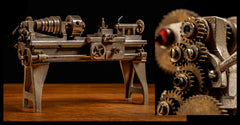
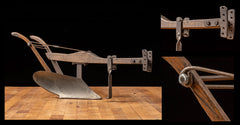
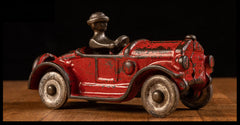



Leave a comment